
Impatiens walleriana, also known as busy Lizzie, balsam, sultana, or simply impatiens, is a species of the genus Impatiens, native to eastern Africa from Kenya to Mozambique. The Latin specific epithet walleriana honours a British missionary, Horace Waller (1833–1896).

Streptanthus cordatus is a species of flowering plant in the mustard family known by the common name heartleaf twistflower. It is native to the western United States, where it can be found in many types of sagebrush, woodland, and forest habitat. It is a perennial herb producing a branched or unbranched stem up to about a meter tall. It is often waxy in texture. The basal leaves are oval or spoon-shaped with bristle-toothed blades borne on rough-haired petioles. Leaves higher on the stem are oval to lance-shaped, up to 9 centimeters long with their bases usually clasping the stem. Flowers occur at intervals along the upper stem. Each has a calyx of sepals roughly a centimeter long which begin greenish yellow and mature purple. Four purple petals emerge from the tip of each calyx. The fruit is a thin, narrow silique which may reach 14 centimeters in length or longer.
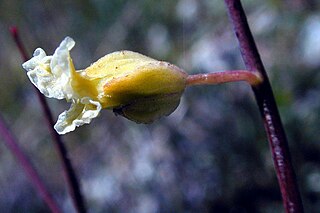
Streptanthus glandulosus is a species of flowering plant in the mustard family known by the common name bristly jewelflower. It is native to California and southwestern Oregon, where it grows in many types of habitat, including grassland, chaparral, and woodlands. Genetic and other analyses indicate that it is a species complex with ten subspecies which evolved as populations were isolated from each other. The complex includes subspecies previously considered separate species, such as the rare Tiburon jewelflower endemic to the San Francisco Bay Area. Plants in the complex are variable. In general they are annual herbs growing 10 centimeters to over a meter in height. They may be hairless to hairy to bristly. The ephemeral basal leaves have blades borne on winged petioles. Leaves higher on the stem are linear to lance-shaped and clasp the stem at their bases. Flowers occur at intervals along the upper stem. Each flower has an urn-shaped calyx of sepals one half to over one centimeter long which can be most any color from white to yellowish to pink or purple to nearly black. Purple, white, or purple-veined white petals emerge from the tip. The fruit is a straight or curving silique up to 11 centimeters long.
Streptanthus morrisonii is an uncommon species of flowering plant in the mustard family known by the common name Morrison's jewelflower. It is endemic to California, where it is known from the North and Central Coast Ranges. It is limited to serpentine soils in chaparral and forest habitat. It is considered a species complex which includes Streptanthus brachiatus. S. morrisonii is divided into four subspecies and is variable. In general, it is a biennial herb producing a hairless, waxy stem up to 1.2 to 1.5 meters in maximum height, often branching at the tip. The basal leaves have fleshy, lance-shaped blades 3 to 5 centimeters long borne on petioles. The blades are gray-green on the upper surface and purple or purple-mottled underneath. Leaves higher on the stem are variable in shape and become smaller toward the top of the plant. Flowers occur at intervals along the upper stem. Each has an urn-shaped calyx of keeled sepals in shades of yellow-green to purple. The petals emerging from the tip are whitish with purple-brown veining. The fruit is a flattened straight or slightly curved silique up to 8 centimeters long.
Streptanthus oliganthus is an uncommon species of flowering plant in the mustard family known by the common name Masonic Mountain jewelflower. It is native to western Nevada and eastern California, where it grows in the rocky hills east of the central Sierra Nevada. Its habitat includes forest, woodland, sagebrush, and mountain talus. It is a rhizomatous perennial herb producing a hairless, waxy, usually unbranched stem up to about 40 or 50 centimeters in maximum height. The basal leaves have lance-shaped, smooth-edged blades up to 10 centimeters long borne on fuzzy to rough-haired petioles. Leaves higher on the stem have shorter blades which may clasp the stem at their bases. Flowers occur at intervals along the upper stem. Each has a bell-shaped calyx of purple sepals no more than a centimeter long. The petals emerging from the tip are reddish purple or purple-tipped. The fruit is a smooth, flat, straight or slightly curved silique up to 8 to 10 centimeters long.
Viola aurea is a species of violet known by the common names golden violet and bright yellow violet. It is native to eastern California and western Nevada, where it is known from scattered occurrences in various types of dry habitat such as the slopes of desert mountains. This herb grows from a tough taproot and produces a woolly-haired stem up to about 13 centimeters tall. The leaves have toothed or wrinkled, rounded or oval blades borne on petioles. They are coated in thick, white hairs. A solitary flower is borne on an upright stem. It has five yellow petals, the lowest one marked with brown veining and the upper pair tinged with brown or purple on the outer surface.

Viola bakeri is a species of violet known by the common name Baker's violet. It is native to the Western United States, from Washington and Oregon, to the mountains of northern Nevada, and in California to the southern High Sierra Nevada.
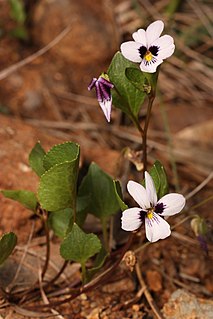
Viola cuneata is a species of violet known by the common name wedgeleaf violet. It is native to southwestern Oregon and northwestern California, where it occurs in the forests of the coastal mountain ranges, often on serpentine soils. This rhizomatous herb produces a hairless stem reaching a maximum height of a few centimeters to around 25 centimeters. The basal leaves have purple-veined green oval, rounded, or wedge-shaped blades borne on long petioles. Leaves higher on the stem are smaller. A solitary flower is borne on a very slender upright stem. It has five white petals with yellowish bases, the lateral two and usually upper two with purple spots. Their outer surfaces may be deep purple to red, and the lowest three are generally marked with purple veining.

Viola douglasii is a species of violet known by the common name Douglas' violet, or Douglas' golden violet. It is native to western North America from Oregon through California and into Baja California, where it grows in seasonally moist habitat, often on serpentine soils. This rhizomatous herb produces a cluster of erect stems just a few centimeters in length to about 20 centimeters in maximum height. The leaf blades are deeply dissected into several narrow lobes or compound, made up of leaflets, and borne on long petioles. They are hairless to softly hairy in texture. A solitary flower is borne on a long, upright stem. It has five bright or deep yellow petals with brown veining and brown outer surfaces. The largest lowest petal may be over 2 centimeters in length.

Viola lobata is a species of violet known by the common name pine violet. It is native to western North America from southern Oregon through California and into northern Baja California, where it occurs in mountain ranges and foothills. It grows in woodlands and other habitat. This rhizomatous herb produces an erect stem a few centimeters tall or growing to nearly half a meter in maximum height. The leaves have variously shaped blades borne on long petioles. The blades are 5 to 15 centimeters wide and may be hairless, hairy, or waxy in texture. The leaf blades are often divided into narrow lobes or dissected into small segments. The shape of the leaf blade differentiates the two subspecies; ssp. lobata has dissected leaves and ssp. integrifolia has entire or toothed blades. A solitary flower is borne on a long, upright stem. It has five yellow petals, all five or just the lower three with purple or brown veining and the upper two stained with purple or brown on the outer surfaces.

Viola ocellata is a species of violet known by the common names pinto violet, two-eyed violet, and western heart's ease. It is native to southern Oregon and northern and central California, where it occurs in the coastal foothills and mountain ranges. It sometimes grows in serpentine soils and in quicksilver mines.
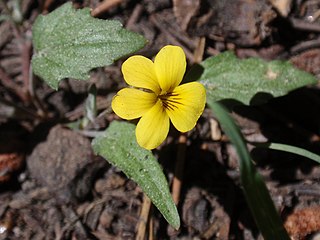
Viola pinetorum is a species of violet known by the common names goosefoot violet, goosefoot yellow violet, gray-leaved violet, or mountain yellow violet. It is endemic to California, where it grows in mountain ranges throughout the state. It occurs in various types of mountain habitat, including forests and talus. This herb grows from a tough taproot and produces an erect or decumbent stem up to about 22 centimeters long. The leaves are linear to oval in shape with pointed tips and toothed edges. The longest ones reach 15 to 20 centimeters in length. A solitary flower is borne on a long, upright stem. It has five yellow petals, the lowest three veined with brownish purple, and the upper two with brownish purple coloring on the outer surfaces.

Viola praemorsa is a species of violet known by the common names canary violet, Astoria violet, and yellow montane violet.
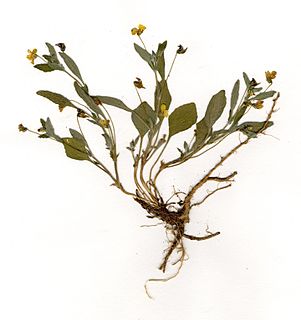
Viola tomentosa is a species of violet known by the common names feltleaf violet and woolly violet. It is endemic to the central Sierra Nevada of California, where it occurs in various types of dry mountain forest habitat. This small herb grows from a deep taproot, reaching a maximum height of 5 to 10 centimeters. The herbage is coated with woolly hairs. The leaves have oval blades borne on petioles a few centimeters long. A solitary flower is borne on a short upright stem. It is under a centimeter long with five yellow petals. The lower three petals are veined with dark brown and the upper two are stained brown or purplish on the back sides.
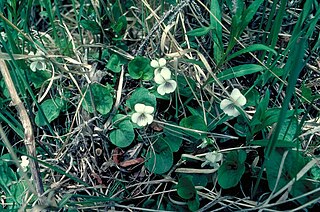
Viola renifolia is a species of violet known by the common names white violet and kidneyleaf violet. It is native to northern North America, where it has a widespread distribution across Canada and the northern United States as far south as Washington, Colorado, and New York.

Viola flettii is a species of violet known by the common name Olympic violet. Native to the northeastern and eastern Olympic Mountains of Washington in northwestern United States, it occurs on rocky outcrops and talus at subalpine and alpine elevations, i.e., from 1,340–2,000 metres (4,400–6,560 ft), and blooms from June through August. This rhizomatous herb produces a hairless stem reaching a maximum height of a few centimeters to around 15 centimeters. The basal leaves have purple-veined green reniform blades borne on petioles. Leaves on the flower stem are similar but smaller. A solitary flower is borne on a slender upright stem. It has five purplish-violet petals with yellowish bases, the lower three with purple veins. The lateral pair are bearded as is the stigma. The spur on the lowest petal is much shorter than the petal.
Iris heweri is a plant species in the genus Iris, it is also in the subgenus Iris and in the section Regelia. It is a rhizomatous perennial, from Afghanistan. It has tall, green curved leaves, tall slender stems and purple blue or violet-blue flowers, with white and purple or lilac beard. It is cultivated as an ornamental plant in temperate regions.

Diuris punctata, commonly known as the purple donkey orchid is a species of orchid which is endemic to south-eastern continental Australia. It has two grass-like leaves and up to ten purple or mauve flowers, often with darker, sometimes yellow marks. A yellow form from near Guyra is probably now extinct.

Marantochloa purpurea is a species of plant in the family Marantaceae. It is found in tropical Africa, where its natural habitat is moist lowland forest. The leaf stems are used for various purposes including making string, baskets, mats and traps and the leaves are used for thatching, and for wrapping objects.

Iberis amara, called wild candytuft, rocket candytuft and bitter candytuft, is a species of flowering plant in the genus Iberis, native to Belgium, France, Germany, Great Britain, Italy, Spain, and Switzerland. It has been introduced to numerous locations including Algeria, Sweden, Eastern Europe, the Caucasus, Iraq, Kazakhstan, the Indian Subcontinent, Korea, Far Eastern Russia, New Zealand, Argentina, Ecuador, Hispaniola, the United States, and Canada. It prefers to grow in warm and sunny conditions, in high-calcium soil.
















